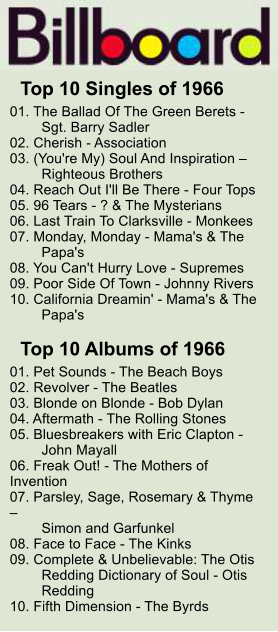There were well over a dozen people in the production -- pictured here above and to the right -- one
most noteably, Sue Lumsden, who would go on to a very successful career in radio and TV in
various Southern Ontario locations. The band consisted of four horn players and a five-piece
rhythm section: Vuk Kovinich, lead guitar; Bruce Wilson, rhythm guitar; Dave Goodrow, bass
guitar; Dave Balan, drums; Cliff Hunt, trumpet; Bill Magee, trumpet; Darrell Nameth, saxophone;
Paul Goodrow, trombone; and Mike Lansbury on lead vocals.
Their Hulse’s Heroes show was a huge success. The Aldershot High students loved the band and
wanted to book them for their next big Aldershot High School dance. And so began the band that
would become known as the Brass Union.
The 1960’s were an intense and turbulent time. Society was
changing in ways that would change it forever and by 1966,
things were not well in most parts of the world. France withdrew
from NATO and Indira Ghandi took power amid India’s worst
famine in 20 years. In Vietnam, Lyndon Johnson was ramping up
the conflict to nearly a half million troops and by year’s end, Hanoi
and Haiphong were being bombed. In North America, the
National Organization for Women was formed, beginning the
women’s liberation movement. Racial unrest was spreading
through the US and Canada with activism, marches and death.
Civil rights activist James Meredith was shot while trying to march
across Mississippi. A few weeks later Martin Luther King was hit
by a rock thrown by an angry white mob on his march through
Chicago. It was little wonder that the year saw the formation of
the Black Panthers, a militant black organization, and the
following summer (1967) would be called the 'summer of love', as
youth tried to fight back against the escalating violence.
And nowhere were these changes more visible than in North American
popular culture and the music that came from it. Fashion was now
coming from London's Carnaby Street as youth made their own protests
with mini-skirts, bell-bottoms, flowers and outrageously-colourful
patterns. Bob Dylan echoed the sentiments of the era with the release
of his “Blonde on Blonde” album – one of the first significant ‘double
albums’. Simon and Garfunkel’s ‘Sounds of Silence’ debuted in 1966,
the title track written by Paul Simon in 1964, following the assassination
of J.F. Kennedy. The Rolling Stones released the single, “Black is
Black”, which probably sums up best, many of the feelings circulating in
late 1966. And the Number One single from the Billboard Charts in 1966
(listed to the right) was, appropriately, Sgt. Barry Sadler’s, “Ballad of the
Green Berets”.
1966 was also the year that coloured television sets became popular in
North America. On the tube, the first Batman, Star Trek, Monkees and
Mission Impossible episodes were aired. Hogan’s Heroes, first aired in the
fall of 1965, continued to be one of the more popular shows of the year.
And from this television program came the first ideas for a band that would
eventually become known as the Brass Union.







Aldershot High School, the alma mater of Canada's own Jim Carrey, is
located half-way between Burlington and Hamilton, Ontario, Canada.
In the fall of 1966, the school boasted very creative music and arts
departments – as so many schools did back then. The music teacher,
Glenn Mallory, was an excellent teacher who I would later have myself
in my own high school in Hamilton. Early in the school year, he had
his students working on a number of Gilbert and Sullivan songs and
some of the students wrote a skit, complete with acting, music and
reworked lyric lines, spoofing the TV series Hogan’s Heroes. They
called their
production, Hulse’s
Heroes, named
after one of the
show’s creators,
Steve Hulse, and
performed their
show for a
Christmas concert
in the high school in
the fall of 1966.





Aldershot High School -- from the 1966 Yearbook









The Idea: (theme music)









